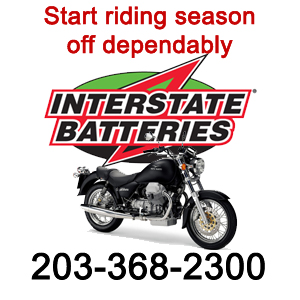Riding a motorcycle safely and properly is a skill that must be learned through practice. A special permit or operator’s license is required to operate a motorcycle in Connecticut. All motorcyclists are strongly encouraged to obtain motorcycle training through a quality course and to take refresher rider courses.
Troopers recommend that before getting on your motorcycle, put on a helmet manufactured to standards set by the U.S. Department of Transportation. Connecticut law requires that motorcyclists wear eye protection, so be sure to protect your eyes with a shield on the helmet, goggles or shatterproof eyeglasses. Wearing leather pants, gloves, boots and jacket, even on warm days, offers protection in the case of a fall from the motorcycle. Troopers also recommend wearing reflective clothing since it is often difficult for other motorists to spot motorcyclists on the roads. Always be visible. Never ride under the influence of alcohol or drugs, and ride within your limits.
Motorcyclists are reminded to use extra caution and awareness at intersections, where most motorcycle vs. vehicle crashes occur. Never drive in an operator’s blind spot. On two wheels where balance is key, motorcyclists must anticipate movements more than drivers of four-wheeled vehicles. Greater emphasis on defensive driving is vital. For example, anticipate that drivers backing their cars out of driveways may not see you. Motorcyclists must also be more cautious when riding in inclement weather, on slippery surfaces, or when encountering obstacles on the roadway.
The National Highway Transportation Safety Administration (NHTSA) reports that about 5,000 motorcycle operators and hundreds of motorcycle passengers lose their lives in accidents each year in the United States. These numbers account for about 13 percent of total traffic fatalities, even though motorcycles account for just three percent of all registered vehicles. In addition to the fatalities, about 100,000 operators and passengers are injured each year.
Motor vehicle operators also have a role in motorcycle safety; they can help to make the roads safer for motorcyclists by taking some simple precautions:
Be extra cautious on weekends when more motorcyclists are likely to take to the road. Provide motorcyclists adequate room to maneuver. As when following another motor vehicle, leave a reasonable distance, following at least
three to four seconds behind the motorcycle or vehicle in front of you. Motorcyclists may need to slow down, stop or adjust their lane position depending on the obstacle in the road; therefore allow extra maneuvering room in areas with potholes, pavement transitions and railroad crossings. Remember, motorcycles have the same right to roadway lanes as any other vehicle. If a motorcycle is nearby, check your mirrors carefully before changing lanes. Motorcycles may be in your blind spots or difficult to see because of their smaller size.
(Connecticut State Police Press Release)
This report is made possible by:

